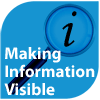 Honing Your Research Presentation
Honing Your Research Presentation
Jinfo Blog
3rd February 2015
Abstract
Anja Thygesen considers three essential questions when taking on a research project - and explains why a project cannot be properly framed unless you have identified the level of analysis required and end use.
Item
 Being a good researcher is one thing, showing it is another.
Being a good researcher is one thing, showing it is another.
Quite a common problem for information researchers is that the focus is on finding and researching and less on the presentation of the results. This may be fine if your "client" has enough time to go through the material you deliver but in many cases time is one of the reasons why you were asked to do the research in the first place.
Essential Questions
To help your client and to get credit for your hard efforts on the research, you should consider these three essential questions:
- Who is your client?
- Why have you been hired for the job?
- How will the results be used?
Taking these things into consideration can help you decide on the level of detail, format of output and communication of the results.
Some clients may actually like to get many details, all sources, your verbal comments and will even continue doing the research based on your findings. Others just want to get the answer "yes" or "no" and not to be bothered with the details. It all comes down to the three essential questions.
What Level of Analysis is Required?
- Presentation of the results can be basic but with some help and guidance provided to the client on how to interpret the findings and how to identify the key "gems" within that
- In other situations the results can be semi-structured with your basic formatting or analysis of the data
- Presentations in a high value-added version are most often full reports with an analysis and visualisation of the data and findings.
In all cases you should consider how to help your client in the best way possible and how you can push the barriers of their understanding of what you can deliver.
Exceed Expectations
Give them something extra! It can be just a short summary of "other findings" or whatever you picked up during the research.
And remember to keep the research in mind after finishing the request. You may come across an interesting article, a useful conversation at a dinner party or something else that you can give the client and show that you still have the request in mind.
Last but not least; don't be afraid of trying an alternative format for your analysis or to push yourself outside your comfort zone. This is a great way of learning something new!
Find Out More
In the Subscription Article "Presenting Research Results" Anja Thygesen provides detail on some of her most important learnings when it comes to the degree and type of data crunching and writing up reports.
She covers different ways to present and visualise data, how everyday tools such as Excel and PowerPoint can provide surprisingly powerful visualisations, and how to ensure that the presentation methods chosen meet the audience and end use.
This Blog Item is part of the FreePint Topic Series "Making Information Visible".
- Blog post title: Honing Your Research Presentation
- Link to this page
- View printable version
- Taking the Mystery Out of Big Data - Moving from Data Collection to Competitive Actions
Monday, 2nd February 2015 - Presenting Research Results
Friday, 23rd January 2015 - Turn Your Insights into Action with the Latest Tools for CI Communication
Thursday, 29th May 2014 - Using Infographics to Promote Information Services
Wednesday, 10th July 2013 - Prezi: Set Your Presentations Free
Thursday, 13th June 2013
- Needs Assessment for Information Visibility - Attend Our CoP Event
Friday, 30th January 2015 - A Deep Dive into Information Discovery
Tuesday, 27th January 2015 - The Latest Visualisation Techniques Should Be Part of the CI Professional's Toolbox
Friday, 30th May 2014
Register for our next Community session:

Transforming knowledge management at BASF – GenAI and the evolution of QKnows
10th December 2025
Latest on our YouTube channel:
Read on the Blog:
December 2025 update
3rd December 2025
- Jinfo wins CILIP’s inaugural “McFarlane & Ward Information Management” award
4th December 2025 - December 2025 update
3rd December 2025 - Review of Matchplat – combining AI with traditional industry code searching
27th November 2025
- Team roles and AI (Community) 26th February 2026
- Team demand and AI (Community) 22nd January 2026
- Transforming knowledge management at BASF – GenAI and the evolution of QKnows (Community) 10th December 2025